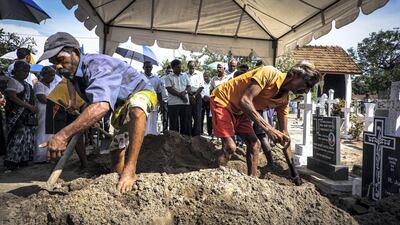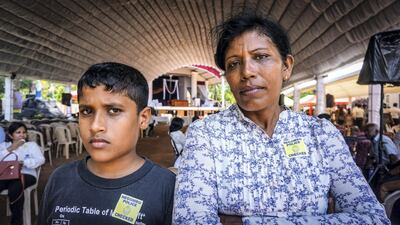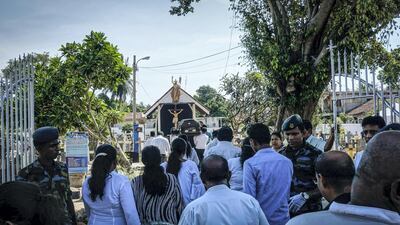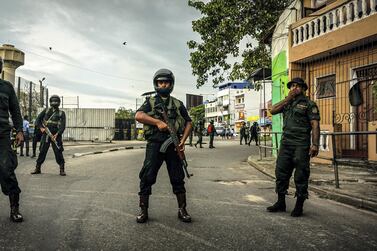As S D Suran, 11, stood outside the main entrance of St Sebastian’s Church in Negombo on Sunday, he spotted a man with a blue backpack.
Holding his tambourine and ready to play with his prayer band, the dark-haired Catholic boy watched the bearded figure move around the building.
Security footage showed the man passing a father, who was holding the hand of his young daughter, and entering the church through a side door towards the end of the Easter Sunday Mass.
Once inside, among a congregation estimated at about 1,500, he pressed his detonator.

The boy’s mother, housewife Swarma Suran, 49, was also outside St Sebastian’s, a Gothic building modelled after the Reims Cathedral in France.
She saw a flash and debris flying across the courtyard.
Her son cried wildly at the chaos around him. He remained in shock for two days.
“Too many lives have been lost in this church," Ms Suran says on Tuesday at a memorial tent set up outside the church. “I always come here but I have never seen something like this.”

Negombo’s gentle waters on Sri Lanka’s western coastline once sheltered the colonial fleets of the Portuguese, Dutch and British.
But on Easter Sunday, the city known as "Little Rome" for its Catholic population, provided no haven for its Christian community.
The city, 22 kilometres north of the capital Colombo, was the scene of the deadliest of eight co-ordinated blasts across Sri Lanka.
The attack was claimed by ISIS and blamed by the Sri Lankan government on a little-known radical group, National Tawheed Jamaat.
The attack at St Sebastian’s killed at least 104 people and wounded 36, a health official said.
Minuri Fernando, 26, an employee at Sri Lankan business conglomerate Hayley’s, was also outside when the blast ripped through the building.
“There was a sudden explosion," Ms Fernando says. "After that, there was a one-minute silence. Then there was a lot of screaming, they came out of the church bleeding.
“I saw everything. We had no strength to even walk. It was the scariest moment in my life.”
A national day of mourning on Tuesday commemorated the 320 victims of the attacks on hotels and churches in the city, Colombo and Batticaloa.
Houses and streets around Negombo were adorned with white flags to commemorate the dead.
But as relatives of the dead and members of the congregation returned to the church to grieve, so did the fear.
Soldiers stood in the heat to guard the approaches to the church. Visitors entering were patted down and had their bags searched.
At least one paranoid member of those gathered at the church asked another if they were Muslim because of their name.
Funerals in the city were being staggered three or four at a time, unannounced to the public for security reasons, says Cardinal Malcolm Ranjith, the Archbishop of Colombo.
At one funeral 1.5 kilometres from the church, about 50 Christians mourn the loss of Lionel Perrera, 75, who had attended Mass alone on Sunday and been killed in the explosion.
Gathered in a cramped room, the mourners sing a Sinhalese prayer that translates to “Trust in God”. When it is time to move to the cemetery, they sprinkle perfume to cleanse the body.
A police car escorts the cortege to the nearby graveyard, where pall bearers dressed in white carry the casket past a half dozen security officers.
Every funeral has a police escort in Negombo because of concerns about secondary attacks. An air force officer in attendance says this is the 12th funeral for which he has provided security since Sunday.
Mourners hummed prayers as the coffin is lowered into the ground. Two men quickly fill in the grave.
But identifying and burying those killed in the Easter Sunday tragedy has not been as easy in Negombo.
The city’s main hospital, which has space for 16 bodies in its mortuary, received more than 100 dead.
The extra bodies are stacked under tarpaulins outside the morgue, where an air-conditioning unit cools the air to 16°C, far above the temperature needed to slow decomposition.
The bodies, many of which bore horrific wounds, had been identified by Tuesday – all except the corpse of the bomber, whose head was missing. His remains were passed to security services for further investigation.
At least 36 wounded remain in hospital, a health official says. Many only survived because of the quick lifesaving actions of those around them.
Rev Father Sanjeewa Appuhamy, 36, the assistant priest at St Sebastian’s Church, was seated to the left side of the altar, out of view of the main church hall, when the bomb detonated.
“I saw my people bleeding, weeping and running to identify their parents, their brothers, their sisters,” Fr Appuhamy said.
“I helped them to stand, to find people, and we called taxis and all the people to take them to the hospitals.”
Inside the church building are pockmarked walls, a statue of Jesus with the head missing, and a hole in the roof where the explosion forced the debris skyward.

Members of the congregation express mixed feelings about returning to church now that they have become a target on an island that has lived in relative peace for a decade. The attack was the deadliest against Christians on Sri Lankan soil.
“People are very scared about what happened. It’s tragic,” says Hashan Perera, a Catholic priest in his 30s who travelled from Colombo to show solidarity.
“It’s a terrifying situation. There is fear. We hope this will end soon.”
But Fr Appuhamy says his flock will “surely come back because their Lord is there” and they, like him, will “have to give forgiveness” to the terrorists who turned their church into a slaughterhouse.
Security forces have asked Christian congregations not to gather until they are confident that the threat to their lives has diminished.
A curfew remained in place across the country on Tuesday night. The country is still under a state of emergency and security forces have locked down Colombo to search for a suspected van filled with explosives.
The military has invoked wartime emergency powers that hark back to the decades-long civil war with the separatist Tamil Tigers.
While displays of solidarity with Sunday's victims continue, recriminations also fly in earnest.
Venerable Battiya Thero, 39, a Buddhist monk who travelled to St Sebastian’s to pay his respects, says Sri Lankans have warned the government for three years about a radical problem on the island.
“We had a sense that something wrong was happening,” he says. “The government didn’t take action. Where was the intelligence service? It’s a crisis.”
The congregation of St Sebastian’s celebrated its 150th anniversary this year and the memories of Sunday’s attack will probably have a legacy just as long.
For now church leaders are focusing on immediate healing, planning for house calls and trauma counselling when the initial shock passes.
“We are trying to build up their family lives,” Fr Appuhama says. “We want to build up the spirit in their heart.”
With additional reporting by Willy Lowry





